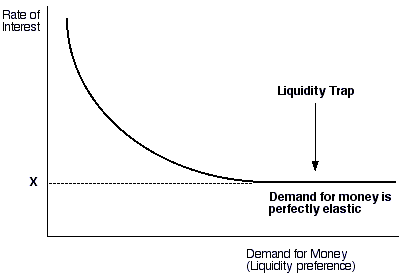John P. Hussman, Ph.D.
All rights reserved and actively enforced.
“There is the possibility… that after the rate of interest has fallen to a certain level, liquidity preference is virtually absolute in the sense that almost everyone prefers cash to holding a debt at so low a rate of interest. In this event, the monetary authority would have lost effective control.”
John Maynard Keynes, The General Theory
One of the many controversies regarding Keynesian economic theory centers around the idea of a “liquidity trap.” Apart from suggesting the potential risk, Keynes himself did not focus much of his analysis on the idea, so much of what passes for debate is based on the ideas of economists other than Keynes, particularly Keynes’ contemporary John Hicks. In the Hicksian interpretation of the liquidity trap, monetary policy transmits its effect on the real economy by way of interest rates. In that view, the loss of monetary control occurs because at some point, a further reduction of interest rates fails to stimulate additional demand for capital investment.
Alternatively, monetary policy might transmit its effect on the real economy by directly altering the quantity of funds available to lend. In that view, a liquidity trap would be characterized by the failure of real investment and output to expand in response to increases in the monetary base (currency and reserves).
In either case, the hallmark of a liquidity trap is that holdings of money become “infinitely elastic.” As the monetary base is increased, banks, corporations and individuals simply choose to hold onto those additional money balances, with no effect on the real economy. The typical Econ 101 chart of this is drawn in terms of “liquidity preference,” that is, desired cash holdings, plotted against interest rates. When interest rates are high, people choose to hold less cash because cash doesn’t earn interest. As interest rates decline toward zero (and especially if the Fed chooses to pay banks interest on cash reserves, which is presently the case), there is no effective difference between holding riskless debt securities (say, Treasury bills) and riskless cash balances, so additional cash balances are simply kept idle.


